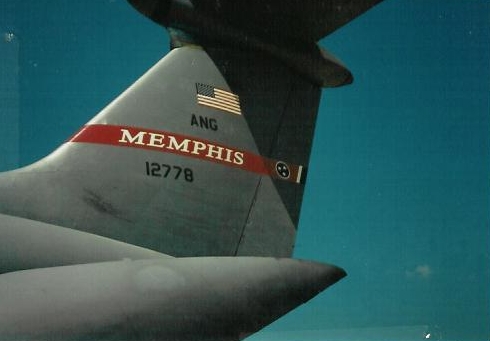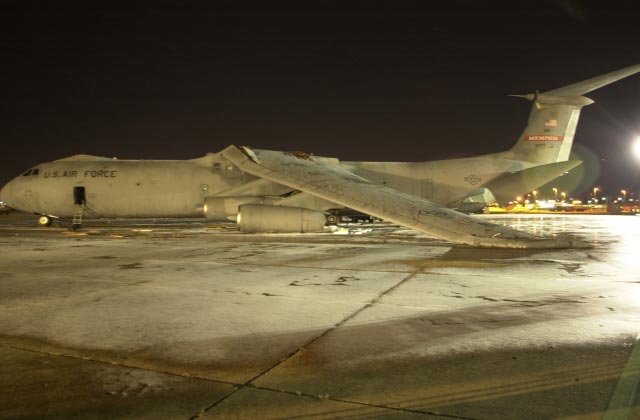
Aircraft 61-2778 was the first C-141 to be accepted by the USAF as an operational jet airlifter. This also made this plane the first jet airlifter in the world. In the early 90's it had its center wing box replaced due to cracking (as most of the C-141s did) and also underwent conversion from a B to a C model. This conversion involved an all glass cockpit.

On the ramp @ McGuire, 1970
Copyright © - Steve Williams, used with permission
See more of Steve's photos @

Copyright © - Don Gilham

Copyright © - Don Cook

Copyright © - Don Cook

Copyright © - Don Cook

Copyright © - 1992 - Al Winzerling
Location: Kadena AB, Japan

At McChord August 29, 1993
Copyright © - Paul Carter
In December of 2001, 61-2778 suffered a catastrophic wing failure due to to a refueling accident. Fortunately, the plane was on the ground at the time. If you have photos of this aircraft in better times please send them to me so we can show it in its prime.
Mike's comment: When I flew C-141's in the mid-70's, there's a good bet we could/would have been given a waiver to the MEL to continue fly this aircraft (as shown below) in order to make an 'on time' takeoff. I don't remember for sure, but I don't think 'wings' were explicitly listed in the MEL.
Here's a new story from CNN:
ATLANTA, Georgia (CNN) -- The Air Force temporarily grounded its fleet of
C-141s
to determine why the wing of a C-141 Starlifter collapsed during refueling
for a
trip to Germany.
Military engineers from Warner Robins Air Logistics Center near Macon,
Georgia,
were in Memphis, Tennessee, on Sunday to investigate the incident, which
happened
Friday night at Memphis International Airport.
The damaged wing of the Air National Guard aircraft spilled about 9,000
gallons
of jet fuel onto the tarmac at the National Guard facility located on the
grounds
of the airport.
"We're trying to ascertain whether it's just a single airplane problem or
if it's a fleet wide problem" said Col. Fred Smith, vice commander of the 164th
Airlift Wing of the Tennessee Air National Guard.
Crews were able to contain the spill before fuel reached Nonconnah Creek,
Smith said. The C-141 was holding 120,000 gallons of fuel when the wing
collapsed, and some of the fuel still was being drained on Sunday.
An airman who slipped in some of the fuel suffered a broken leg, and another
strained his shoulder, Smith said. Another got fuel in his eye, but was
able to flush it out, and required no medical treatment.
The following information was provided to us by a witness to the incident.
The aircraft in question was aircraft 61-0778. The nose art was of an old man
in a robe with an hourglass and a sickle and was titled "Father Time". Aircraft
-778 was the first C-141 to join the USAF and be accepted as an operational jet
airlifter. This also made this plane the worlds first jet airlifter. In the
early 90s it had its center wing box replaced due to cracking (as most of the
C-141's did) and also underwent conversion from a B to a C model. This conversion
involved an all glass cockpit.
After 9/11, our unit (164th Airlift Wing) deployed to Germany. This plane
went with us and up until the accident day, it was one of the best and most
reliable planes that we had.
The cause of the mishap came down to fatigue and bad communication. A fuel
leak had developed in the accident wing in the #2 main tank. The plane was
pulled into the fuel barn (the hangar in the background of the photos). The leak was repaired
and pressure plugs were inserted in the place of the vent plugs. The wing
was charged with compressed air. The theory being that if the tank would hold a
certain pressure for a certain time, then the leak must be fixed. This also
allowed for the replaced panels to "seat."
The plane was then taken back out to the line and refueling started for her next trip to
Germany later that day. The personnel who performed the repairs had put in a 20 hour day and
went home. Follow on personnel did not swap the pressure test plugs for the vent plugs. As fuel
flowed into the #2 main, which is the closest to the fuselage, the air had nowhere to go and
compressed until it blew out the skin. Unfortunately, the pressure was so great that it broke
the wing spar in the process.
Thus ended the life of the first ever C-141. The plane has been stripped of
useful parts and the hulk cut up as scrap. The back third of the fuselage
was sent back to Lockheed for corrosion studies of the airframe.
Source: CNN news archives.
And a follow up story about the incident:
DECEMBER 23, 2001 - MEMPHIS, TN. - Entire C-141 Air Force Cargo Fleet
Grounded
Throughout Country
New developments tonight regarding the collapse of a wing on a C-141 cargo
plane bound for Ramstein Air Force base. News Channel 3's Todd Angkasuwan reporting.
We have learned that every C-141 air force cargo plane throughout the country has been grounded
indefinitely. An official investigation hasn't begun yet, but engineers are assessing damage.
Meanwhile, members of the 164th Airlift Wing are baffled as to how the wing fell off spilling
fuel.
"I just couldn't believe it. It's just unbelievable." Never in Lt. Col. Lamar Spencer's
wildest dreams did he expect to get a call about this. But soon, he saw it with his very eyes.
Around 8:00 p.m. Friday night, the left wing on a C-141 bound for Ramstein Air Force Base fell
off.
"It just collapsed during refueling, and obviously that's not a typical thing." In
fact, Spencer has never heard of this happening...ever. He says the weight shift of the plane
also caused the right wing to come off. But there's something else that bothers Spencer even
more. 42 men and women of the 164th airlift were supposed to be on that plane.
After the fuel spill, crews spent Saturday morning trying to keep 9000 gallons
of fuel from seeping into Nonconnah Creek. Response teams were able to seal off a
nearby storm drain just in time. A structural engineer from Georgia is now assessing the
damage...and the hunt for answers continues
Source: Memphis 'Channel 3' news archives.
And more info about the incident:
Originally, the C-141 was scheduled to depart Memphis on 20 December 2001.
During
preflight inspection a fuel leak was discovered behind engine number two.
Maintenance personnel evaluated the fuel leak and determined that repairs
would
be required prior to departure. The plane was defueled and towed to the
fuel
cell
hangar for repairs.
They were unable to locate or repair the fuel leak, so they inserted fuel
tank
vent plugs and pressurized the fuel tank to locate the leak. The leak was
found
and repaired. Once the repair was completed, the fuel systems technician
exited
the fuel tank but failed to document or request an in-progress inspection
(IPI)
to ensure all tools and materials are removed from the fuel tank and fuel
tank
plugs (if used) are extracted from the fuel tank vents.
Thus a fuel vent plug was not removed. As the aircraft was being refueled,
upon
reaching approximately 120,000 pounds of jet fuel, the interior left wing
fuel
tank pressure exceeded wing structural tolerances, as pressure was unable
to
vent
due to the forgotten fuel vent plug. Over-pressurization resulted in
catastrophic
failure of the left wing structure at the wing root.
PROBABLE CAUSE: "The AIB President found by clear and convincing evidence
that
the primary cause of the mishap was over-pressurization of the left wing
fuel
tanks. The over-pressurization was the direct result of the fuel systems
technician's failure to remove a fuel tank vent plug. The forgotten fuel
tank
vent plug, in turn, caused the fuel tank overpressurization leading to its
rupture."

Copyright © - Kirk Wright
Source: unknown

Copyright © - Kirk Wright
Source: unknown

Copyright © - Kirk Wright
Source: unknown

Copyright © - Kirk Wright
Source: unknown

Copyright © - William H Warner, USAF
Source: contribution to c141heaven from his archives

Copyright © - William H Warner, USAF
Source: contribution to c141heaven from his archives

Copyright © - William H Warner, USAF
Source: contribution to c141heaven from his archives

Copyright © - William H Warner, USAF
Source: contribution to c141heaven from his archives

Copyright © - William H Warner, USAF
Source: contribution to c141heaven from his archives

Copyright © - William H Warner, USAF
Source: contribution to c141heaven from his archives

Copyright © - William H Warner, USAF
Source: contribution to c141heaven from his archives